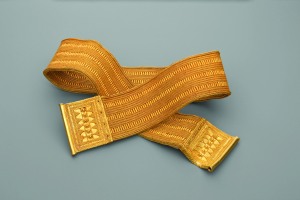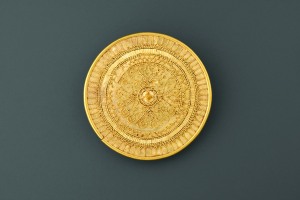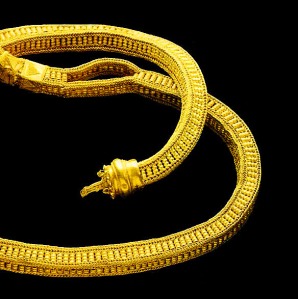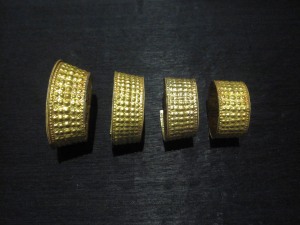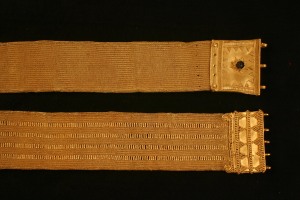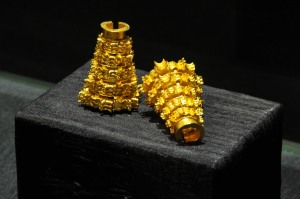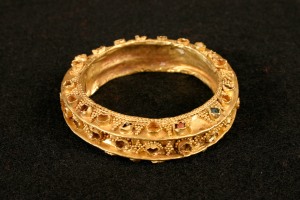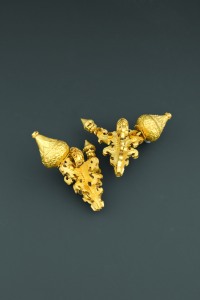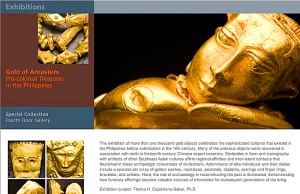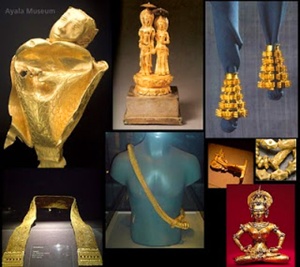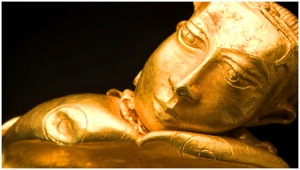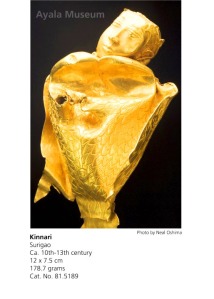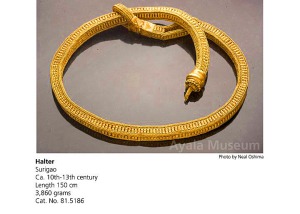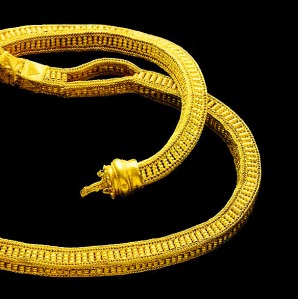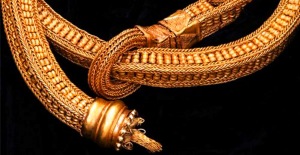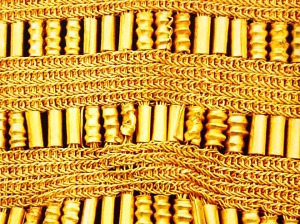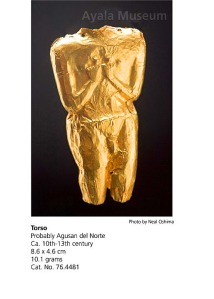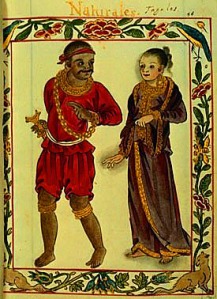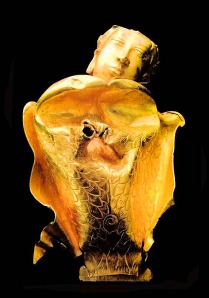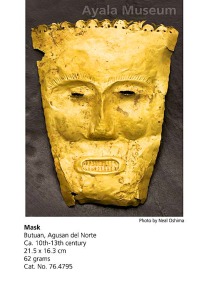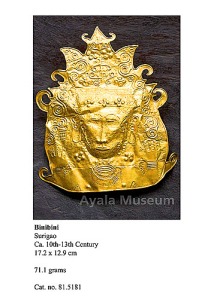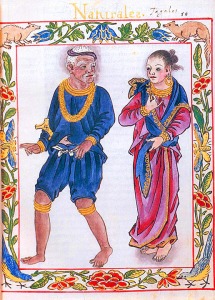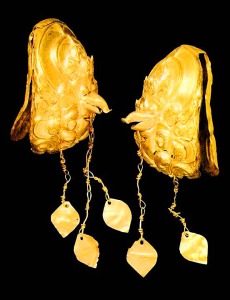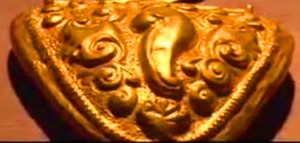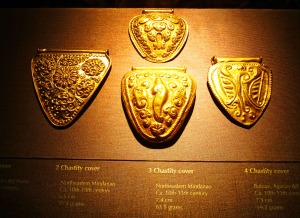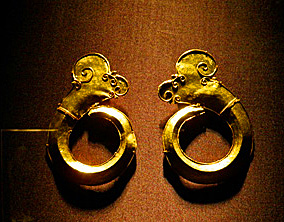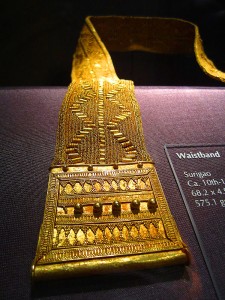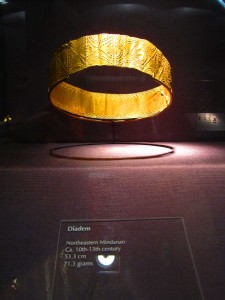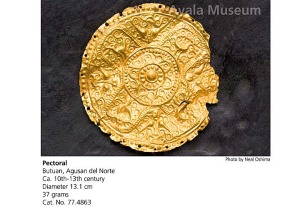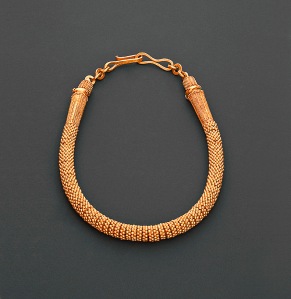Next month, 123 lots of the country’s priceless, 1,000-year old, ancestral gold will make their first journey to the Big Apple.
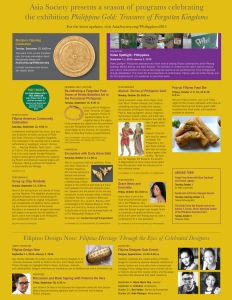
They include the “kinnari”, the half-bird, half-woman denizen of the mythical forests of Mount Meru – the Hindu center of the universe, the solid gold halter – “Upavita” – ten pounds of gold woven into three layers of miniature balls slung across the chest for religious, healing and protective ends, as well some chastity covers, necklaces, chains, waistbands, bangles, ritual bowls, implements and ceremonial weapons.
The treasure trove – part of the combined collection of the Ayala Museum and the Bangko Sentral ng Pilipinas (BSP) – will be packed according to strict “museum standards”, insured for a sum which “cannot be disclosed” before flag carrier Philippine Airlines (PAL) flies it halfway across the globe.
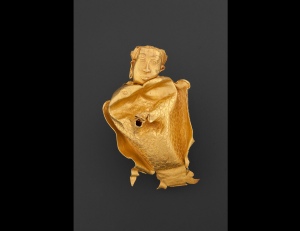
Then, Fil-Ams, Wall Street traders, businessmen, artists and artisans, fashion designers and the American public can feast their eyes on these artifacts crafted by pre-colonial Filipinos more than half a millennium before the first Europeans landed in the U.S.
“Philippine Gold: Treasures of Forgotten Kingdoms” will be showcased at John D. Rockefeller III’s Asia Society Museum, 725 (at 70th Street), Park Avenue, New York. from September 11, 2015 up to early January, 2016.
Yet todate, most of these gold refused to yield their secrets.
Although the core of the collection was unearthed from Butuan, a polity in Mindanao which became prominent in the 13th century, no one knows the names and stories of their craftsmen. No one even knows how they were really used.
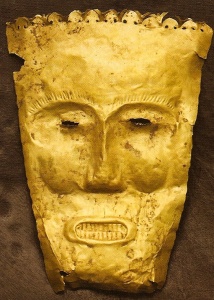
Definitely, a number of the ancestral gold were grave goods, like the funerary masks and the orifice covers that prevent malevolent spirits taking over the body of the dead via fontanel or facial openings in the eyes, nose and mouth.
But some, like the Upavita – one of Ayala Museum’s most valuable artifacts, are not.
Curators say it was meant to be worn but not daily. It’s simply too heavy (it broke the first mannequin on which curators first put it on) although a side slit in the gold wire seemed designed to hold a weapon.
Probably, it was kept for ceremonial purposes or for protection. But no one can be sure. Similar golden regalia have been used by the Brahmin caste in India.
In the same way, “Up to now, we don’t know how the ‘kinnari’ served pre-colonial Filipinos, whether she’s a liquid vessel for daily use because of the hole in her back and her spout-like arms,” admits Ken Esguerra, Ayala Museum’s Senior Curator.
In India, similar artifacts of this Hindu embodiment of beauty adept in music, dance and poetry were used as water vessels and oil lamps. But the Ayala Museum’s Kinnari stood out for her Filipina features.
While she has chased and engraved swan wings and tail, our Kinnari sports a bejeweled chignon, extended earlobes and low-bridged nose.
As for the chastity covers – similar ones have been found in Southeast Asia. Malaysians have them in brass and silver. But only Filipinos have them in gold.
Gold, the “sweat of the sun”, abounds in the Philippines, that’s why. But other than that, little else is known.
Young women wear the chastity covers before marriage as well as wives waiting for their husbands to come home. Some are adorned with flower patterns but most show the conch shell, the symbol of Vishnu, the Preserver and Protector wed to Mother Earth, who is tied to the concept of the universal womb.
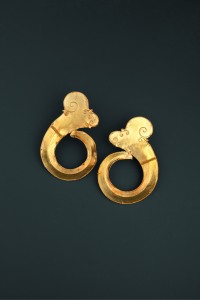
On the other hand, the BSP collection of ancestral gold bound for New York includes the “piloncito” – a gold nugget used as a coin in ancient days, as well as a couple of royal gold belts -“kandits” – weighing over a kilo.
Parisians have seen the BSP gold treasures twice before and were amazed at the sophistication and artistry of Filipino pre-colonial gold ornaments. In the 1990s and in 2013, Musée du quai Branly exhibited them. But this will be the first time Americans will behold them.
“The Philippines tend to be perceived internationally in terms of its colonial history under Spain and under the US. We Filipinos also tend to perceive our cultural heritage in terms of our Catholic, Hispanicized and Americanized identities,” remarked Fernando Zobel de Ayala, president of Ayala Corp.
“This exhibition demonstrates to the international community, and to everyone at home, that the Philippines had a sophisticated culture before contact with the West,” he underscored.
It proves “We had close ties with the Hindu-Buddhist cultures of Southeast Asia and the Asian mainland and that our precolonial culture was actually very similar to those of our Hindu-Buddhist neighbors before Westernization. The superior quality of the gold ornaments also dispels the Western stereotype of pre-colonial Filipinos as ignorant and primitive before Spanish and American intervention.”
In addition, “These artifacts are very little known scholarship-wise, so with the opportunity to bring them to New York, we are holding symposiums that place the collection in the whole realm of historical scholarship in the Austronesian context,” puts in Asia Society Philippine Chair Doris Magsaysay-Ho.
Philippine Gold: Treasures of Forgotten Kingdoms is made possible by Ayala Corporation, with additional support provided by exhibition partners Bank of Philippine Islands, Del Monte Foods, Inc., Philippine Airlines, ABS-CBN The Filipino Channel and Tourism Promotions Board Philippines and exhibition benefactors CLSA, Coca-Cola FEMSA Philippines, First Philippine Holdings Corporation, Goldman Sachs Gives, J.P. Morgan, Philam Life, an AIA Company, San Miguel Corporation, UBS AG and Western Union
Asia Society Museum, founded by John D. Rockefeller 3rd in 1956, is a nonpartisan, nonprofit institution with headquarters in New York, centers in Hong Kong and Houston, and offices in Los Angeles, Manila, Mumbai, San Francisco, Seoul, Shanghai, Sydney, and Washington, DC.
Asia Society Philippines Trustees include: Washington SyCip, Founding Chairman; Doris Magsaysay-Ho,Chair; Jorge L. Araneta, Joselito D. Campos, Jr., TeresitaSy-Coson, Frederick Y. Dy, Jaime Enrique Y. Gonzalez, Oscar M. Lopez, Atty. Ricardo J. Romulo, Edward A. Tortorici, Luis J.L Virata, Fernando Zobel de Ayala.
Asia Society Museum hours: Tuesday through Sunday from 11:00 A.M. – 6:00 P.M. and Friday from 11:00 A.M. – 9:00 P.M. Closed on Mondays and major holidays. General admission is $12, seniors $10, students $7, and free for members and persons under 16. Free admission on Friday evenings, 6:00 P.M. – 9:00 P.M. The Museum is closed Fridays after 6:00 P.M. from July 1 through Labor Day.

